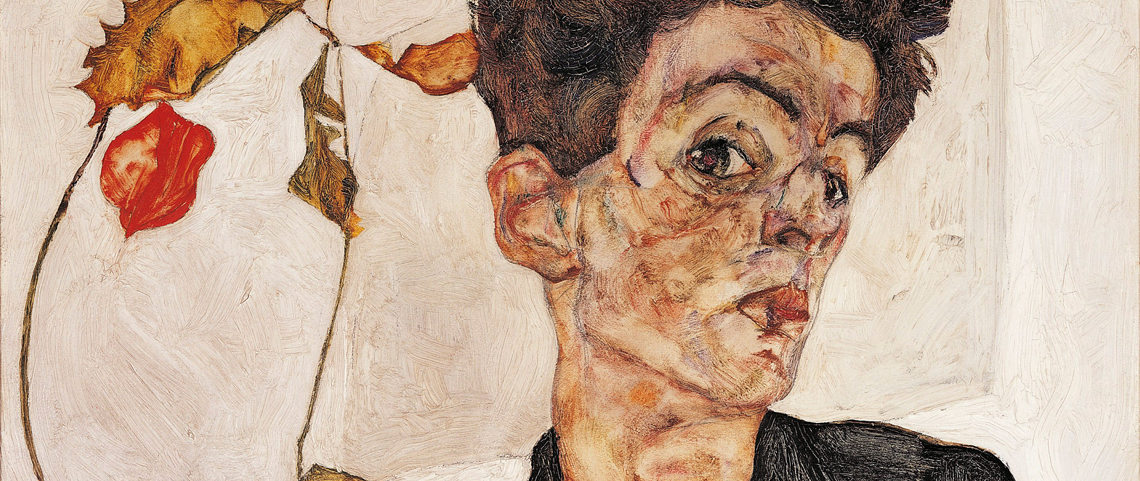
Egon Schiele – 100 Years On
The 31st of October 2018 will mark the 100th anniversary of the death of the prolific Austrian expressionist Egon Schiele, a fascinating artist famous for the scandals that surrounded him both personally and professionally. To commemorate a century since his passing, we have collated a few highlights from his impressive portfolio found in our archives, while recording some of the stories that surrounded them.
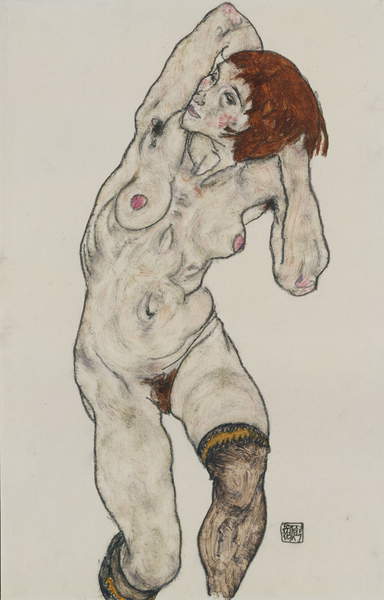
Standing Nude in Black Stockings, 1917 (w/c and charcoal on paper), Egon Schiele (1890-1918) / Metropolitan Museum of Art, New York, USA / Bridgeman Images – Accents of colour on top of charcoal was a common trope of Scheile’s work, as was the twisted and awkward limbs opposed to a depiction of soft, classic femininity.
Schiele was born into modest means on the 12th of June 1890 in Tulln, Lower Austria, to the station master of Tulln Station, Adolf Schiele, and his wife, Marie née Soukup. As a child, Schiele was fascinated by the trains with which his father worked, and would spend hours sketching and painting them. Possibly due to concern surrounding his son’s poor academic performance, his father disapproved of Schiele’s artistic pastimes and burnt many of Egon’s sketchbooks. After his father’s death in 1905, however, Schiele became the ward of his maternal uncle and under his uncle’s care was permitted an art tutor. A year later he was accepted at Kunstgewerbeschule (School of Arts and Crafts) in Vienna, where his idol Gustav Klimt had once studied, and then in 1906 moved to the more traditional Akademie der Bildenden Künste.
Upon the young man searching him out, Gustav Klimt became Schiele’s mentor and influenced much of his work until Schiele’s own distinctive style emerged in 1911. His art is immediately recognisable for its unconventional graphic style, overtly erotic depictions, and figural distortion, contrasted with a more traditional expression of classical beauty often found. His self-portraits in particular were virtually unmatched in western art, both in the sheer volume of self-portraiture he produced and in the highly revealing, self-eroticising male nudity they presented.
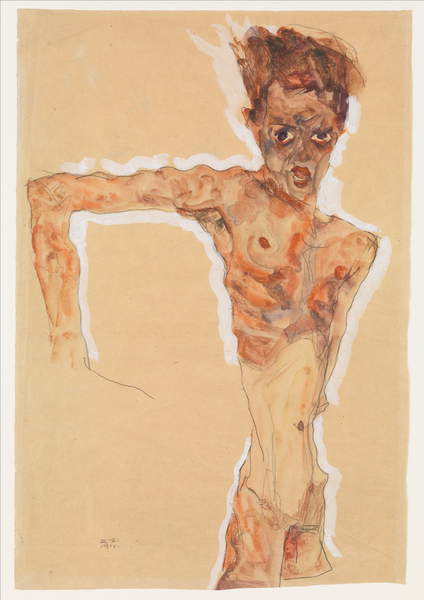
Self-Portrait, 1911 (w/c, gouache, and graphite on paper), Egon Schiele (1890-1918) / Metropolitan Museum of Art, New York, USA / Bridgeman Images – A grotesque and twisted image of self, with none of the exaggeration of masculinity often found in male nudes.
He was known by his contemporaries for an alleged sexual deviance fuelled by the sensual nature of his pieces. He was also thought to have kept many mistresses, such as his main muse and the subject of many of his most striking portraits, Wally Neuzil, though supposedly he slept with many of his models. Many of them were also thought to be prostitutes, which garnered much criticism, though the general attitude at the time towards the immorality behind female sexuality means that these rumours need to be taken with a pinch of salt. For his contemporaries it was not just the act of extramarital sex that deserved critique, since this was not unusual in early 20th century Austria, but also the act of moving the private and sexual into the public sphere. It confounded and disgusted many consumers, stimulating allegations of depravity.
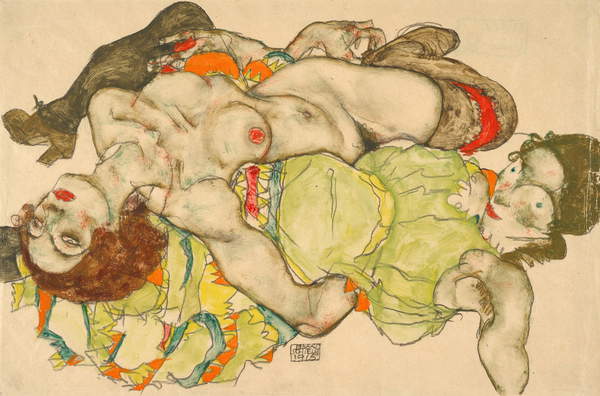
Female Lovers, 1915 (gouache and pencil), Egon Schiele (1890-1918) / Graphische Sammlung Albertina, Vienna, Austria / Bridgeman Images – Doll-like faces, striking unlifelike colour combinations, and inhuman twisted bodies archetypal of Schiele’s later work.
His studio was a common meeting place for lower class ‘degenerate’ children, which was another point of great scandal for his local communities. When Schiele was arrested under the accusation of seducing a minor, the police seized over one hundred of his paintings and drawings, claiming them to be overtly pornographic. Though charges concerning the young girl were dropped, a third charge was levelled against Schiele which stuck: that his works of art were a crime of “public immorality”. During his trial the judge was even alleged to have burned one of the offending drawings. Scandal followed him and his work even after he passed away. After Adolf Hitler came to power in 1933, Schiele’s paintings came under criticism once again and many were seized, sold, and burned by the Nazi party, under the conviction of degenerate art.
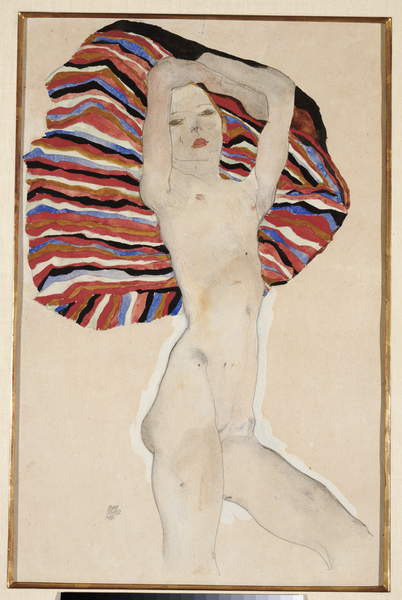
Act Against Coloured Material, 1911 (w/c, gouache & pencil on paper), Schiele, Egon (1890-1918) / Private Collection / Photo © Christie’s Images / Bridgeman Images – An androgynous gender fluidity found in the subject was revolutionary, as was the self-possessive erotic gaze from the model.
That is not to say his work was not also widely admired, his death at the young age of twenty eight preceded a huge breakthrough in popularity. Despite rumours that followed him in life and in death, he created pieces that are as arresting as they are stunning and the excellence of both his nude portraits and other works is undeniable.
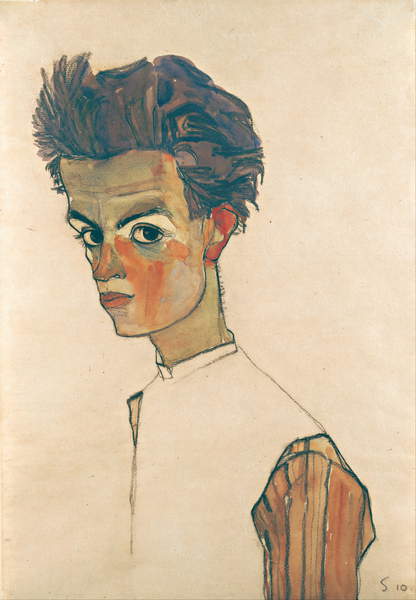
Self-Portrait with Striped Shirt, 1910 (graphite & w/c on paper), Egon Schiele, (1890-1918) / Leopold Museum, Vienna, Austria / Bridgeman Images
On the Bridgeman Images site there can be found more of his artwork, as well as portraits and photographs of the artist himself.
